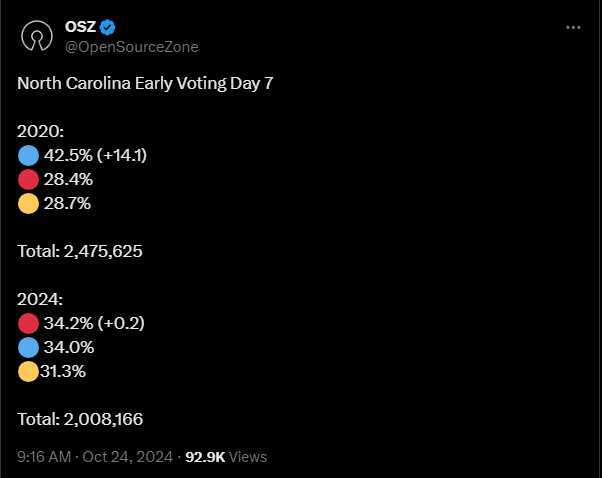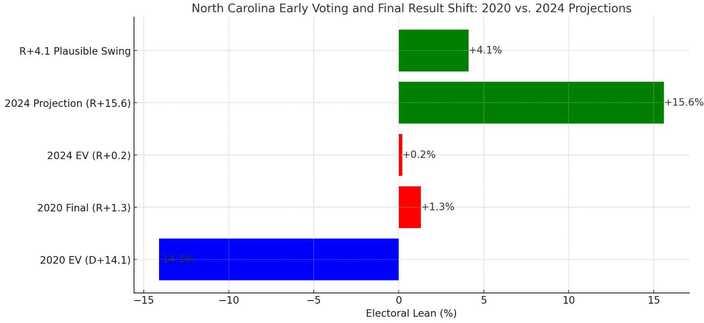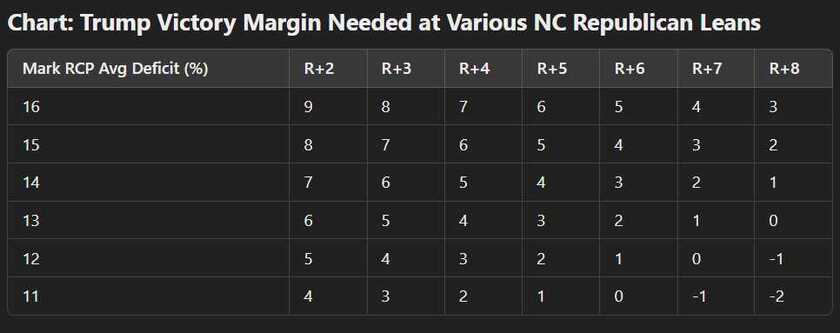
With 11 days left until Election Day, North Carolina’s early voting trends reveal a shift to R+2—a sharp change from the D+9 lean seen at the same point in 2020. There’s also potential for the GOP advantage to increase to R+4, offering Mark Robinson a path to overcome his 13.8% polling deficit. His success will hinge on Trump’s performance, GOP momentum, and straight-ticket voting.
How the Math Suggests an R+4 Outcome
In 2020, Democrats had a +14.1% EV lead by Day 7, but the final result was Trump +1.3% statewide. This suggests a 15.4-point swing toward Republicans between early voting and final Election Day results.
2024 Projection:
- If Republicans maintain their +0.2% lead in early voting, applying the same 15.4-point swing from Election Day turnout suggests:
- 0.2% + 15.4% = R+15.6% final result.
- While this high swing might be extreme, even a quarter of that swing (3.85 points) results in R+4.1%, which aligns with a plausible outcome.

Additional Factors Supporting R+4:
Unaffiliated Voters:
- The share of unaffiliated voters remains stable at 31.3% (compared to 28.7% in 2020). Historically, these voters have leaned Republican in recent cycles, which could further boost the GOP margin.
Lower Democratic Turnout:
- With early voting turnout down 19% and Republicans leading by +0.2%, the lower enthusiasm among Democrats suggests the GOP could gain more ground by Election Day.
Republican Early Voting Surge:
- Republicans performing well in early voting—traditionally a Democratic stronghold—indicates a potential realignment in voter behavior, increasing the likelihood of an R+4 result or higher.
Trump’s Victory Margins and Coattail Impact
Here’s how Trump’s performance must align with different GOP leans to narrow Robinson’s deficit:
- R+2 Election: If Robinson is down by 14 points, Trump must win by 7 points to make Robinson competitive.
- R+3 Election: With a 13-point deficit, Trump must win by 5 points.
- R+4 Election: If the GOP advantage grows to R+4 and Robinson is down by 13 points, Trump only needs to win by 4 points, and so on...
Key Factors in Robinson’s Path to Victory
1. Straight-Ticket Voting is Essential
While North Carolina has a history of split-ticket voting, national trends show growing support for straight-ticket ballots. Robinson must rely on this trend to win down-ballot votes alongside Trump.
2. Trump’s Performance is Critical
On Point Politics, which has one of the most accurate aggregate models from the 2020 election, projects Trump to win North Carolina by 8 points. If Trump reaches this margin, Robinson would narrow his polling deficit substantially and remain competitive.
3. Unaffiliated Voters are the Wildcard
With 31.3% of early voters registered as unaffiliated, this group will determine the final outcome. If they align with Republicans, Robinson’s path to victory strengthens.
4. Momentum Must Continue
The +6 swing from Emerson polling shows favorable momentum toward Robinson. If this trend holds, he could close the gap even further before Election Day.
Visualizing the Shift: Early Voting Trends
Below is the shift from the D+9 lean in 2020 to the current R+2, with the potential to reach R+4.
Chart: Shift in North Carolina Early Voting Trends

Conclusion: A Narrow but Real Path to Victory
Mark Robinson’s victory will require several key elements aligning perfectly:
- Trump must win by 8 points or more, as projected by On Point Politics.
- The GOP lean must grow from R+2 to R+4 to maximize Robinson’s chances.
- Straight-ticket voting must override the state’s traditional split-ticket behavior.
- Unaffiliated voters must break toward Robinson and the GOP.
If these conditions hold over the next 11 days, Robinson has a narrow but achievable path to victory. With early voting favoring Republicans and Trump’s projected margin increasing, Robinson’s chances are improving. The next few days will be critical in determining whether this momentum continues, potentially delivering a win for Robinson in North Carolina.
















